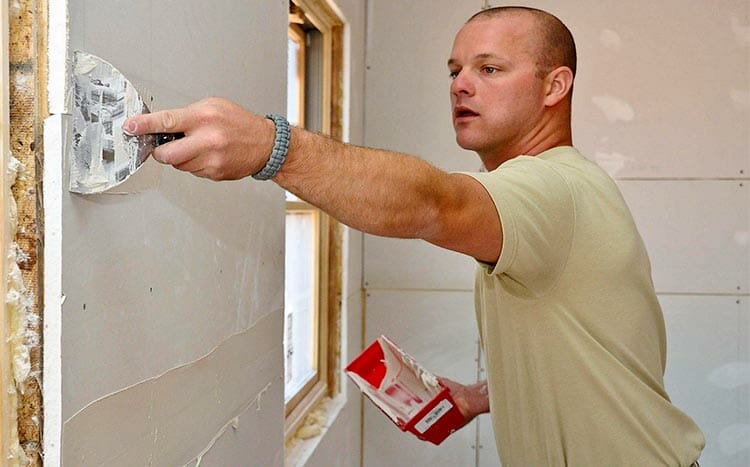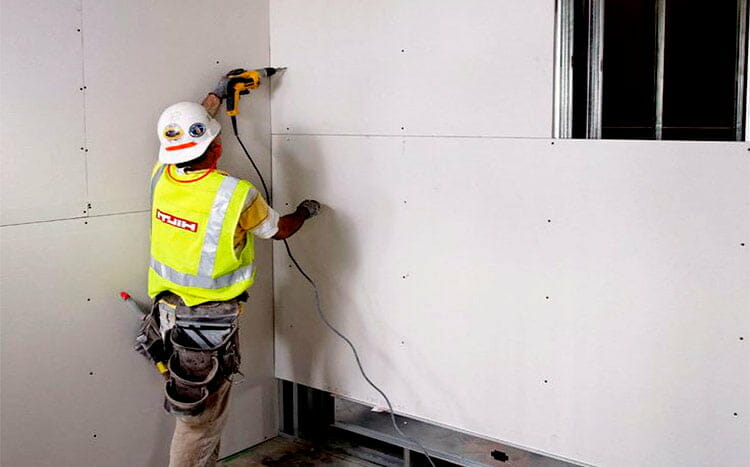Although built to last, drywall may experience damage over time, requiring either repair or replacement. Keep reading to discover the appropriate times to fix or replace your dryalm and the correct way to do it.
The amount and type of damage on your drywall will determine whether you need to have it repaired or replaced. For instance, water damage will lead to replacement in a lot of cases where punch holes can just be repaired.
Below are the types of damages that occur on drywall. Some of them can be rectified with a simple repair while others call for replacement of the entire drywall for various reasons.
Cracks in Drywall
By the time the drywall develops cracks, it usually means its structural integrity has been compromised either through age, weaknesses, natural aging, or impact caused by natural and artificial sources. Any type of crack on drywall could be a sign of something bigger.
Cracks on drywall can be a result of minor issues or significant problems such as:
- Changes in temperature
- Humidity
- Mold
- Bad weather such as earth tremors
- Pests (such as rats)
- Structural weaknesses brought about by improper installation or rough weather
- Age
- Physical impact
You should replace drywall that has both small and significant cracks especially if they appear suddenly. Cracked drywall is a potential hazard to house occupants because it can crumble at any time. Those who live in areas that experience rough weather such as hurricanes or storms should pay particular attention to any cracks on drywall before and after bad weather.

Punch Holes
Punch holes in drywall are quite common, especially on rental property. Luckily, punch holes do not signify any structural weaknesses in the entire drywall and can be repaired easily depending on their size. Small to medium-sized punch holes can be fixed with readily available materials at home or by a professional repairman.
You can follow these steps to repair small punch holes on drywall at home:
To repair small or medium-sized punch holes (6 inches or smaller in diameter), you will need some reinforcement material, off-the-shelf drywall patches, some joint compound, and sandpaper.
Insert the drywall patch as shown on the label then apply the joint compound and sand it to perfection. It’s a simple job that shouldn’t take you more than an hour to complete.
Bigger holes that are larger than six inches in diameter need more work and should be repaired by a professional. Sometimes it may also be easier and cheaper to replace an entire section of drywall instead of repairing it.
Water Damage
Water damage on drywall is probably the worst thing to deal with because of the nature of drywall and the limited repair options available. In most cases, any sort of water damage usually calls for the entire section of the drywall to be torn down and replaced.
Water usually seeps into drywall causing rotting and weakening the internal structure of drywall. Keep in mind that drywall is quite sturdy so any sort of water damage is probably due to long periods of exposure due to leakages and flooding. Water-damaged drywall is like a sponge on the inside and could also attract toxic mold over time.
However, you also need to assess the amount of damage to the drywall before you decide on what to do with it. Check the surface area of the affected areas and see if it’s significant enough to warrant tearing down the entire wall. You may also need to assess the extent of the water damage to see if it’s only on the surface meaning a repainting job would suffice.
Mold
The presence of mold on and inside drywall is usually a bad sign and will most likely force you to tear down the affected wall section and replace it with a new wall. Mold presence on drywall usually means that there is significant and prolonged water damage, cracks in drywall, broken internally installed water pipes, or roof leaks.
It’s very difficult to get rid of toxic mold embedded in drywall even when a professional mold remediation team is called. To be sure that the health of occupants is guaranteed, most professionals would advise that you get to the bottom of the matter by first removing affected drywall and fixing any leaks or sources of moisture and condensation.
Mold is usually attracted to moist and warm surfaces. Its presence on the surface of drywall usually means there is a lot more of it inside the wall embedded in wet insulation and cracks within. These are the first places most mold inspectors would look when they are looking for the source of mold in your home.
More importantly, it’s good to mention here that prolonged exposure to most types of black mold can have adverse health effects on your loved ones and pets too. The CDC advises that exposure to black mold over long periods can trigger unexplained health symptoms in humans and should be eliminated as soon as it is discovered.
Joint Issues
It is common for drywall to develop structural issues at the joints mostly due to faulty installation or age. If you see problems at any of the joints on the drywall in any room, it’s advisable to have the damage assessed professionally and fixed to preserve the integrity of the wall. Giant cracks or holes at the joints could cause the entire wall to crumble over time.
There are many problems you might encounter especially with drywall joints as a homeowner. Here are some of them:
- Thick joints due to improper installation
- Bare spots
- Improper setting and drying
- Bulging seams
- Mold
- Vertical cracks, among others.
Depending on the type of damage observed on the joints, you may need to have the entire section of drywall torn down and installed properly.
However, minor issues such as bulging spots can be corrected easily. If it’s a new house, pay close attention to how each joint is done on drywall to avoid problems in the future.

Dented Drywall
It’s hard to get rid of large dents on drywall especially if it occurred through physical impact or structural failures resulting from improper installation. Removing a section of drywall and filling it up with bonding compounds or fillers may not be ideal due to other installations under it such as electrical wiring. Luckily, it’s quite easy and affordable to replace a section of drywall.
Small dents or dinks can however be repaired using readily available joint compounds or filler. Just mix your joint compound into a good texture and fill in the dink using a normal trowel. Make sure you put enough joint compound in there so that it does not recess after drying. You may need to repaint that part of the wall if the joint compound used is of a different color or shade. Fixing minor dents or dinks usually takes a few minutes and does not require special skills or equipment.
Peeling Drywall
It’s very common to have drywall that is peeling from the inside or to have paint peeling off drywall. This usually occurs due to any of the following issues common in most homes:
- High humidity, splashing, or flooding
- Exposure to the elements
- Wrong paint or primer used
- Extreme drying
- Dirty surfaces
- High temperatures
- Poor installation
- Old Coats of paint
Most of these issues cause significant damage to the appearance and integrity of drywall. It is best to replace that section of drywall to address the problem. As an example, peeling drywall due to flooding or poor installation means fixing a part of or repainting the affected area is a temporary fix.
Nail Holes
It’s relatively easy to patch nail holes on drywall using readily available materials like drywall patches and joint compounds or what some refer to as filler compounds. The easiest way to cover the holes is to insert a drywall patch into the hole and cover the surface with the joint compound or filler. Use a normal trowel to flatten the surface and repaint the section if necessary.
Is It Cheaper to Repair or Replace Drywall?
The cost to replace or repair drywall depends on the extent of damage and how big the affected area is. In most cases, it could be cheaper to repair minor issues such as dinks. However, you might find that costs to repair large faults such as cracked joints are higher than tearing the wall and down and replacing it.

Do Painters Repair Drywall?
Most painters also double up as home improvement experts. They usually have the necessary skills and expertise to help with drywall repairs. Make sure you find a painter that is experienced and can be relied upon to do a good job
Here is what you need to do to find an affordable top-rated professional painter in your location today:
- Scroll to the top of the page and enter your Zip code.
- Answer questions about the painting job you want to be done
- The information you enter will be forwarded to three local experts. They will send you a price estimate for the job and some friendly advice.
IMPORTANT: There is no obligation to hire. This is a free tool and service to be used at your pleasure

Can I Drywall Over Old Drywall?
While it might be possible to add new drywall over old drywall, it’s not a very common practice and may cause problems down the line. If you are looking to reinforce your walls, use normal reinforcement material such as wood, steel, and heavy insulation before installing drywall.
Should I DIY Or Hire A Professional?
Dealing with drywall can be hectic and also requires some level of skill to get right. It’s advisable to work with a professional so that you don’t cause more damage or have more problems down the line.







